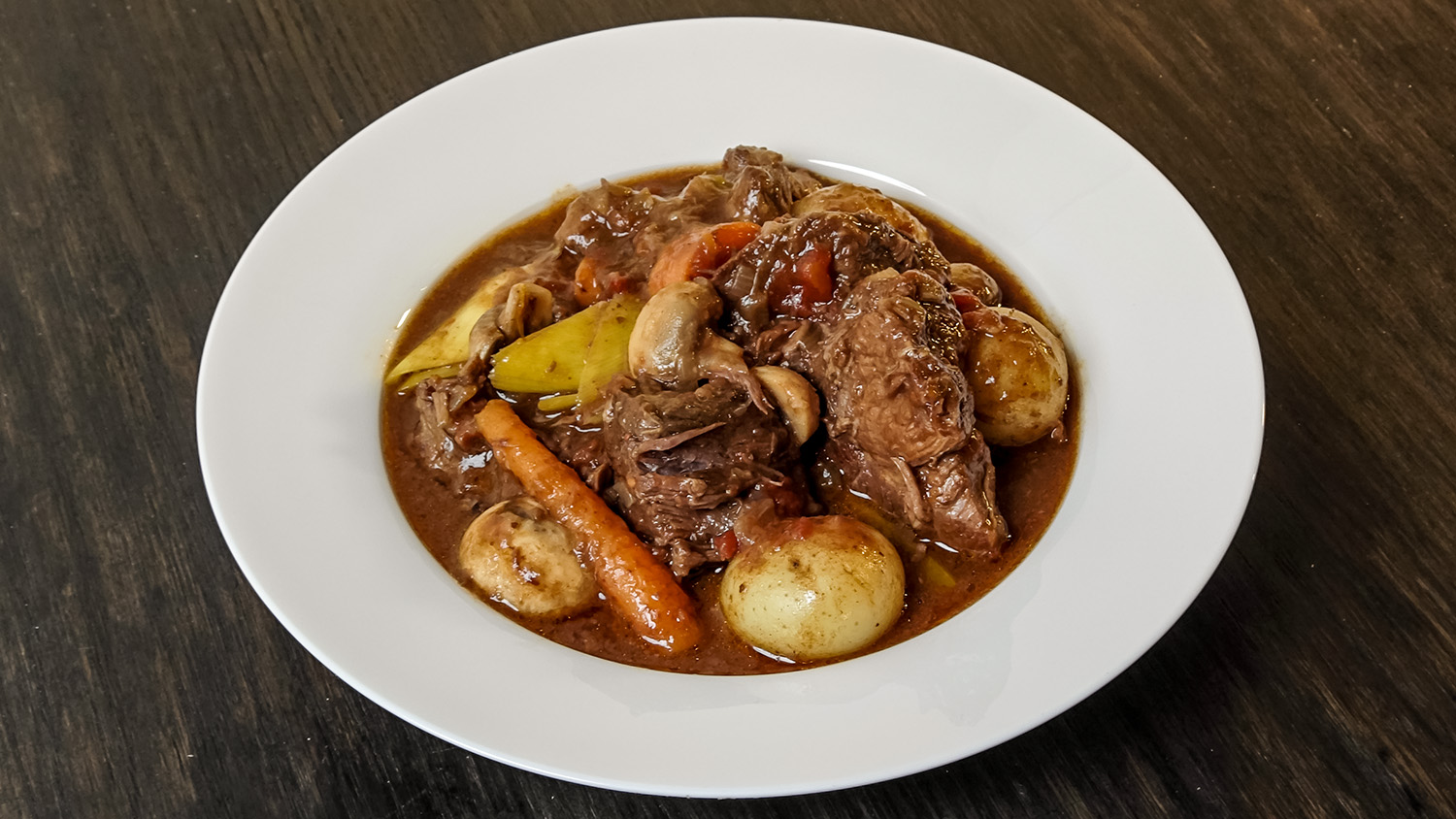Clem's Beef Stew
Few dishes beat a stew for dinner on a cold winter night (here
where the sunset currently sets at 5 p.m.). Stews are made using
mutton or beef, the cuts of which are usually the less
expensive, "tough" (with sinew and connective tissues) variety.
For stews (which are low heat, slow cooked dishes) connective
tissue amongst the meat fibres are desired because they are
collagen which render into gelatine. Properly cooked, these cuts
produce fork tender, tasty meat. The day before dinner, I made
this relatively easy to prepare beef stew.

Clem's Beef Stew
1. Ingredients
Note that the quantities of ingredients are varied to your preference (there is no set amount)
- About 1.5 kg of beef.
I used what is called "Gravy Beef" in Australia.
It is meat from the "chuck" (shoulder) or "round" (hindquarters) of the animal.
Select those cuts which look well-trimmed and marbled where possible.
- Flour for coating the meat.
- 2 large onions.
I also used 6 - 8 French shallots (whole).
- 4 -5 cloves garlic (can be whole).
- Ground pepper (or not as you
like).
- Some carrots.
I used two carrots plus a bunch of baby Dutch carrots as these were in season.
- Mushroom (choose whatever is
available).
I used button mushroom.
- 1 leek (sliced).
- Green peas.
- Diced tomatoes (or some tomato
puree).
I used 1 can.
- Cooking oil and butter.
- Chat/new potatoes (or not as you
prefer).
- Worcestershire sauce (a dash or two).
- Beef or chicken stock.
I used chicken powder.
- Red wine (or not as your prefer).
I used a cabernet merlot.
2. Preparation
- Trim gristle and sinews off your
chosen meat cuts.
Cut the beef into large chunks.
Size is to your preference but having large chunks will ensure that sizable portions of beef will appear in your stew after long cooking.
Note that large chunks take longer to cook.
Ensure that the beef pieces are relatively dry (pat dry if wet - dry pieces will enhance achieving browning during frying).
- Thinly coat each piece of beef
with flour.
- Choose an oven-proof saucepan
large enough to contain all your ingredients.
I used a Dutch Oven.
If you choose not to slow cook in an oven, you may use a saucepan conventionally atop a cooking range but you may need to attend to the cook regularly to stir to ensure that the food does not stick to the bottom of the pan.
- Add cooking oil to the pan and
then some butter for taste and some browning.
In addition, I added some beef tallow as I had some available.
- Fry the beef pieces in batches (so
as not to overcrowd the pan) until the pieces are well
browned (some charring is fine).
You will notice that the pan will accumulate brown font at the bottom and sides. This is fine and will comes off when you deglaze the pan later and during the slow cooking.
- As the meat is browned take it off
and set aside.
- Now, to the oil remaining at the
bottom of the pan, add the diced onion and brown them off.
- When the onions are nearly done,
add the garlic to the fry.
- You then add the diced tomatoes
(or puree).
- After a few minutes of frying,
return the beef pieces to the pan and fry.
- Add several dashes of
Worcestershire sauce.
- Add your chosen stock and let the
whole thing boil with the pan lid on.
I added water and chicken stock powder.
- If you are going to use red wine,
add it now.
I used about a cupful.
- Either,
(i) turn the heat down low to slow cook the beef, or
(ii) place the lidded in an oven set on low heat.
Slow cook for at least two hours, with regular checking on progress.
Continue cooking if the meat has not reached the degree of tenderness which you desire.
- During the slow cooking, add the
various vegetables using your judgement as when, to allow all
to come to a common degree of doneness.
I added carrots, mushroom and potatoes first. Later, I added the leek and peas.
- Taste the stew and add condiments
are desired.
If the stew needs to be thickened to your liking, make a cornflour slurry and stir this quickly into the stew and cook off to fully gelatinize the starch.
- Now your stew is ready to serve
(but probably better the next day) with mashed potato,
seashell pasta, or
crusty bread.
I made pomme puree (https://clemkuek.com/photoalbum/photo696_3t.html) to go with it.
ENJOY!
All my cooking (some without recipes) can be found here (click on each photo to go to that dish's page):
http://clemkuek.com/photoalbum/photo696.html
Video presentations can be found here:
Earlier days: https://youtu.be/BWyHY1h9Y5s
More recently: https://youtu.be/cph2XmwuQLU
12 July
2025
Created by Clem Kuek
